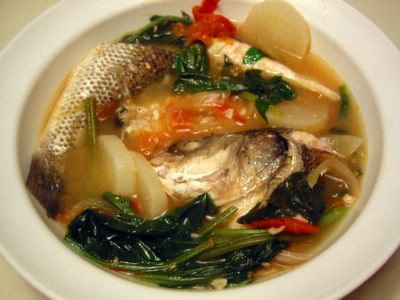
I spied some miso in our local Chinese grocery last week and decided to make this dish which we haven't had for a long time. I don't know how far back this Sinigang sa Miso goes in terms of cooking history but I wouldn't be surprised if it was created only around World War II - with miso being from the Japanese. Though I'm not sure if the Chinese use miso as well, if yes, then the origin of this would go much further back.
We often have this whenever the banks of Laguna de Bay overflow (we lived near when we were in the Phils.) which makes the bangus (milkfish) escape from the numerous fishpens in the lake. This is usually right after a typhoon. It's just one of the several dishes to make the most out of the cheap bangus flooding the market.
The miso lends some salty fermented taste and aroma which blends well with the souring agent and the vegetables of which it's recommended to have white radish and mustard leaves if not use any leafy veggies like kangkong (tung choi) or even spinach.
Sinigang sa Miso
500 - 700 g fish steaks (sea bass, salmon, etc.)
1 Tbsp oil
1 tsp minced garlic
1 medium onion - sliced
3 - 4 medium tomatoes - sliced
3 Tbsp miso paste
1 tsp salt
4 - 5 cups rice water* or water
souring agent (tamarind, lemon and lime, etc.)
1 white radish - peeled and sliced
1 green or red long chili (siling haba) - washed and pointed end cut
bunch of leafy vegetables (kangkong, mustard leaves, spinach, etc.) - washed
- In a medium sized pot, heat oil and gently saute garlic then add onions and cook until onions are translucent.
- Add in tomatoes, cook for 3 minutes or until soft. Mash the tomatoes a little bit.
- Stir in the miso and salt, saute for a minute.
- Pour in the rice water and bring to boil.
- Add in the fish, white radish and chili. Cook on medium heat for 5 minutes.
- Add the leafy vegetables and souring agent. Simmer for 2 minutes.
- Taste soup and adjust seasonings if need be.
*Note: Rice water is the water used in washing rice for plain cooked rice.
No comments:
Post a Comment